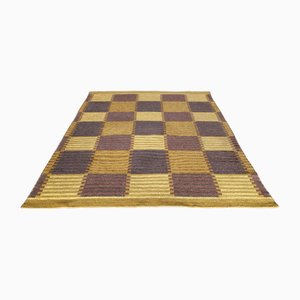
Going against the grain of his contemporaries, Swedish architect-designer Carl Malmsten (1888-1972) was a strong critic of functionalism and a proponent of traditional Swedish craftsmanship. Malmsten was also a devoted educator who sought alternative approaches and methods to developing hand-produced products.
Malmsten was born in 1888 in Stockholm, going on to study at the University of Stockholm, graduating in 1908. He then gained practical experience through a carpentry internship at the Nordic Museum and at Skansen (1909-1910). From 1911 until 1916, he worked in various architectural firms.
In 1916, at the age of 28, Malmsten established his studio in Stockholm, working as a freelancer in furniture design. That same year, he won a furniture competition for Stockholm’s new City Hall. With the exposure of his furniture designs, he soon became a highly sought after designer, and in 1917 exhibited alongside esteemed Swedish architect-designers by the like of Gunnar Asplund and Uno Åhrén at The Home Exhibition. Malmsten’s lifetime goal was to create practical furniture that would developed the user’s well-being and create total harmony within the space the furniture occupied. With a fine eye for detailing, he was meticulous in his construction, often focusing on the direction of fibers, as well as refining and preserving the structure of each piece.
Sometime between 1904 and 1973, he designed for the world-famous NK Department Store in Stockholm. During in the 1920s, Malmsten was commissioned to create furnishings for a number of highly important clients, including the prince of Sweden, Gustaf VI Adolf in the Ulriksdal Palace (1923), Stockholm’s Concert Hall (1928), The Swedish Match Company (1928), Waldorf-Astoria in New York (1930), and the House of the League of Nations in Geneva (1934). Most of his furniture was named after the towns or clients who commissioned them.
In 1930, Malmsten founded the Carl Malmsten Furniture Studies in Stockholm, which later became its own department at the Linköpings University in 2000, offering educational courses in furniture design, cabinetmaking, furniture conservation, and furniture upholstery. In 1957, Malmsten established his second school, Capellagården, on the island of Öland in Vickleby. Today, the school offers courses in textile craft and design, cabinet making, furniture design, interior carpentry, ceramics, and organic horticulture.
Over the course of his illustrious career, Malmsten was awarded with several prestigious awards including the Prince Eugen Medal for design in 1945. Notably, he was a member of Svenska Slojdforeningen (Swedish Society of Industrial Design). He advocated the traditional role of the home as a place for gathering and leisure, believing that the rationalization of the home according to functionalist principles was a perversion of these import roles.
Malmsten passed away in 1972 on the island of Öland in Sweden. Malmsten continued to work, designing and teaching until his death. It is believed that the designer left behind more than 20,000 sketches and detailed drawings of his designs, which today are considered an exclusive cultural heritage and are part of the Siv and Carl Malmsten Memorial Foundation. Malmsten’s contribution to Swedish handicrafts and education is still remembered today, as he wished for future generations to have the opportunity to nurture their innate creative desires. His dedication and passion to Swedish design has afforded him, alongside Bruno Mathsson and Yngve Ekström, the title of one of Sweden's best known furniture designers.

